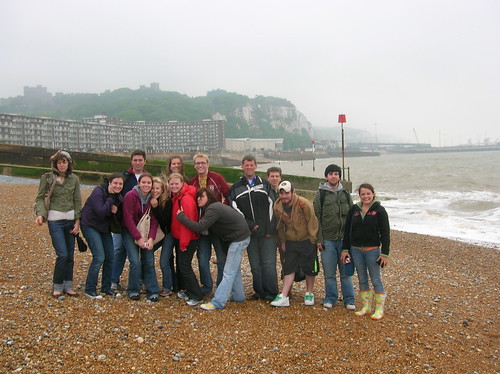Our trip to the United Kingdom is quickly drawing to a close. Only Wednesday remains, so we've packed as much as we could into the last two days.
On Monday we went to Dover to see the white cliffs despite heavy rain and strong winds. The cliff face, which reaches up to 350 feet high, owes its striking façade to its composition of chalk (pure white calcium carbonate) accentuated by streaks of black flint. The cliffs spread east and west from the town of Dover in the county of Kent, an ancient and still important English port. The cliffs have great symbolic value for Britain because they face towards Continental Europe across the narrowest part of the English Channel, where invasions have historically threatened and against which the cliffs form a symbolic guard. We made sure to get a couple of group photos in front of the cliffs.
We then made our way to Canterbury to see the very famous Canterbury Cathedral. Canterbury Cathedral is one of the oldest and most famous Christian structures in England. A pivotal moment in the history of Canterbury Cathedral was the murder of Thomas Becket in the north-east transept on Tuesday 29 December 1170 by knights of King Henry II. The king had frequent conflicts with the strong-willed Becket and is said to have exclaimed in frustration, "Who will rid me of this turbulent priest?" The knights took it literally and murdered Becket in his own cathedral. The death echoed throughout England, and soon pilgrims began making pilgrimages to honor the martyred Becket. These pilgrimages inspired Geoffrey Chaucer to write his famous 'Canterbury Tales'.
On Tuesday we stayed close to home and went to the Imperial War Museum. Inside were the relics of every war the British were involved with: Crimean War, Boer War, WWI, WWII, Korean War, Vietnam War, along with numerous other wars. The meseum honored all men of war, including the great general Monty of WWII, a nickname for Bernard Montgomery, 1st Viscount Montgomery of Alamein, Field Marshal Montgomery, who led all allied ground forces during Operation Overlord. There were replicas of the trench warfare of The Great War (WWI). They even took care to include the same smells that infested the original trenches. It was a very repusive smell. For WWII, the museum had a very moving Holocaust exhibit. We couldn't help but walk out of the exhibit feeling very disgusted at the human race. We are capable of some very cruel things.
We also stopped for tea time at a formal restaurant in London. We tried all kinds of black teas, green teas, finger sandwiches, scones, and little finger candies. We walked out extremely stuffed, and we had some good sugar buzzes!
Tuesday, May 27, 2008
Subscribe to:
Comments (Atom)


